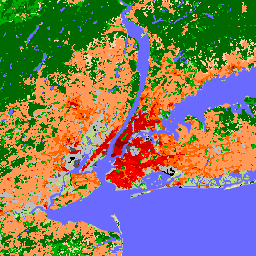
- 데이터 세트 사용 가능 기간
- 2018-01-01T00:00:00Z–2019-01-01T00:00:00Z
- 데이터 세트 제공업체
- 보훔 도시 기후 연구소
- 태그
설명
2012년에 도입된 이후 지역 기후대 (LCZ)는 도시 경관을 특징짓는 새로운 표준으로 부상하여 미세 규모의 토지 피복과 관련 물리적 속성을 고려하는 전체적인 분류 접근 방식을 제공합니다.
픽셀 크기가 100m이고 기준 연도 2018년을 대표하는 지역 기후대의 이 전역 지도는 여러 지구 관측 데이터 세트와 전문가 LCZ 클래스 라벨에서 파생되었습니다. LCZ_Filter는 대부분의 사용자에게 권장되는 밴드입니다. 다른 분류 밴드인 LCZ는 LCZ_Probability 밴드를 계산하는 데 사용되므로 제공됩니다.
LCZ 체계는 도시 및 농촌 경관 유형에 중점을 두어 다른 토지 이용 / 토지 피복 체계를 보완합니다. 이러한 유형은 LCZ 체계의 17개 클래스로 설명할 수 있습니다. 17개의 LCZ 클래스 중 10개는 '건축' 환경을 반영하며 각 LCZ 유형은 도시화에 대한 모델 대기 반응에 중요한 주요 도시 캐노피 매개변수의 일반적인 숫자 설명과 연결됩니다. 또한 LCZ는 원래 도시 열섬 연구를 위한 새로운 프레임워크로 설계되었으므로 '관리' 또는 '자연 참조' 영역으로 사용할 수 있는 제한된 '자연' 토지 피복 클래스 (7개)도 포함되어 있습니다.
LCZ 계획의 이러한 7가지 자연 클래스는 세계의 기존 자연 생태계의 이질성을 포착할 수 없으므로 필요한 경우 사용자는 빌드된 LCZ 클래스를 더 넓은 범위의 자연 지표 클래스를 제공하는 다른 지표 제품과 결합하는 것이 좋습니다.
관련 주제에 대한 추가 정보
대역
픽셀 크기
100미터
대역
| 이름 | 단위 | 픽셀 크기 | 설명 |
|---|---|---|---|
LCZ |
미터 | LCZ 클래스가 포함된 원시 픽셀 기반 전역 LCZ 지도 |
|
LCZ_Filter |
미터 | LCZ 클래스가 포함된 권장 전역 LCZ 지도입니다. LCZ 라벨은 Demuzere et al. (2020)에 설명된 형태학적 가우시안 필터를 적용한 후에 획득합니다. |
|
LCZ_Probability |
% | 미터 | 모달 LCZ가 픽셀당 선택된 빈도를 식별하는 확률 레이어입니다 (예: 확률이 60% 이면 모달 LCZ 클래스가 50개의 LCZ 모델 중 30번 매핑되었음을 의미). LCZ 레이어에서 파생된 픽셀 기반 확률입니다. |
LCZ 클래스 표
| 값 | 색상 | 설명 |
|---|---|---|
| 1 | #8c0000 | 소형 고층 |
| 2 | #d10000 | 컴팩트 미드라이즈 |
| 3 | #ff0000 | Compact lowrise |
| 4 | #bf4d00 | Open highrise |
| 5 | #ff6600 | Open midrise |
| 6 | #ff9955 | Open lowrise |
| 7 | #faee05 | 경량 로우라이즈 |
| 8 | #bcbcbc | 대형 저층 |
| 9 | #ffccaa | 희소하게 빌드됨 |
| 10 | #555555 | 중공업 |
| 11 | #006a00 | 울창한 나무 (LCZ A) |
| 12 | #00aa00 | 흩어진 나무 (LCZ B) |
| 13 | #648525 | 덤불, 관목 (LCZ C) |
| 14 | #b9db79 | 식물이 적은 지역 (LCZ D) |
| 15 | #000000 | 노출된 암석 또는 포장 (LCZ E) |
| 16 | #fbf7ae | 나지 또는 모래 (LCZ F) |
| 17 | #6a6aff | 물 (LCZ G) |
LCZ_Filter Class Table
| 값 | 색상 | 설명 |
|---|---|---|
| 1 | #8c0000 | 소형 고층 |
| 2 | #d10000 | 컴팩트 미드라이즈 |
| 3 | #ff0000 | Compact lowrise |
| 4 | #bf4d00 | Open highrise |
| 5 | #ff6600 | Open midrise |
| 6 | #ff9955 | Open lowrise |
| 7 | #faee05 | 경량 로우라이즈 |
| 8 | #bcbcbc | 대형 저층 |
| 9 | #ffccaa | 희소하게 빌드됨 |
| 10 | #555555 | 중공업 |
| 11 | #006a00 | 울창한 나무 (LCZ A) |
| 12 | #00aa00 | 흩어진 나무 (LCZ B) |
| 13 | #648525 | 덤불, 관목 (LCZ C) |
| 14 | #b9db79 | 식물이 적은 지역 (LCZ D) |
| 15 | #000000 | 노출된 암석 또는 포장 (LCZ E) |
| 16 | #fbf7ae | 나지 또는 모래 (LCZ F) |
| 17 | #6a6aff | 물 (LCZ G) |
이용약관
이용약관
인용
Demuzere M.; Kittner J.; Martilli A.; Mills, G.; Moede, C.; Stewart, I.D.; van Vliet, J.; Bechtel, B. 지구 시스템 모델링 및 도시 규모 환경 과학을 지원하는 지역 기후대의 전 세계 지도 Earth System Science Data 2022, 14 Volume 8: 3835-3873. doi:10.5194/essd-14-3835-2022
DOI
Earth Engine으로 탐색하기
코드 편집기(JavaScript)
var dataset = ee.ImageCollection('RUB/RUBCLIM/LCZ/global_lcz_map/latest') .mosaic(); var visualization = { bands: ['LCZ_Filter'], min: 1, max: 17, palette: [ '8c0000','d10000','ff0000','bf4d00','ff6600', 'ff9955','faee05','bcbcbc','ffccaa','555555', '006a00','00aa00','648525','b9db79','000000', 'fbf7ae','6a6aff' ] }; Map.setCenter(7.26, 51.44, 6); Map.addLayer(dataset, visualization, 'LCZ_Filter');
